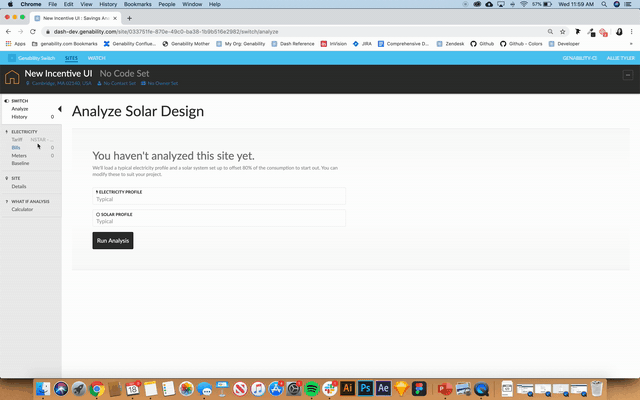Products
Solar Incentives Data
By John Tucker
| Reading time 3 minutes
Genability Switch customers no longer need to maintain their own database of residential solar incentives. As of October 15, 2019 Genability’s Solar Incentives API has graduated from Beta to V1 and is now available under general release for Switch customers that wish to license it. We’ve also built a new user interface within Switch’s Dash web application to view this data along with your savings analyses.
In many regions of the U.S. like Massachusetts and Illinois, solar incentives greatly increase customer savings. Understanding the incentive structure, requirements and availability are crucial when calculating solar savings, and the Solar Incentives API provides Switch customers with a machine-readable, up-to-date data source for solar incentives. Our data is structured in a way to allow you to calculate the economics of the incentive in a fully data-driven way.
If you currently license Switch and are interested in adding our Solar Incentives data via API and Dash website, contact your company’s account owner to to discuss updating your license.
++ Attend the free Solar Incentives webinar on Tuesday November 26th at 10am!
New Incentive Screens in Dash for Switch
We have added a new Solar Incentive user interface within the Switch UI in the Dash web application. You can use it to find available solar incentives for a specific customer. Just log in to Dash, navigate to the site of the customer in question, and select Tariff from the left navigation bar. You will see a new tab called “incentives” (shown below).

By default we only list Solar Incentives that are still active, but you can override that search preference by clicking the “Show Exhausted” button in the top right corner.
What Solar Incentives are Included?
The Solar Incentives API returns the incentives offered by utilities and tax jurisdictions for those customers who install Solar PV Systems for residential properties in the US. These incentives can take many forms including:
- Per kWh credits - An additional payment to solar customers for each kWh their solar system produces (e.g. Massachusetts SMART program, Illinois Adjustable Block Program)
- Cash Rebates - A payment made to the solar customer upon installing solar. Can be a flat rebate or vary by system size (per Watt)
- Tax Credits - Offset the customer’s tax bill (e.g. The Investment Tax Credit)
Genability retrieves solar incentive data directly from the utilities and local governments to ensure that our data is comprehensive and up-to-date. This includes tracking the status of incentive blocks/tranches that adjust the value of the incentive, so you don’t calculate solar savings based upon an expired incentive. The Solar Incentives API does not however include SRECs (Solar Renewable Energy Credits), as those values change continually and are not made public in real time.
Why utilize Genability for Solar Incentive Data?
As anyone who has maintained a solar incentive database will tell you, there’s more to understanding solar incentives than knowing how much the utility or local government will pay your solar customer. Genability collects all the data you need to accurately calculate incentive payments for you or your customer. Beyond the incentive type and value, we collect the following data in machine readable and machine computational form:
- Funding status and block level
- Caps on incentive payments
- Eligible payment recipients (Owner, Contractor or Third Party Owner)
- Jurisdiction, including if multiple incentives in the same jurisdiction can be added together
- Duration of incentive in years
- PV System requirements (e.g. Azimuth, Tilt requirements, system size)
Customer Collaboration means better data for all
We source our incentive data directly from documentation published by the utility or local government. We also use this as a source to inform the status of a specific solar incentive. At the same time, you, our solar customers, are utilizing these incentives and have the most up-to-date first hand knowledge of when they are used up or set to expire. We make sure to update our database as this information flows back to us from the field. If you run across any errors, ommissions or changes in status and eligibility please email us at support@genability.com and we will make the necessary changes.
Integrating the Solar Incentive API
We provide a how-to guide to help software developers integrate the Solar Incentive API on our developer website. It walks you through Finding Incentives, then Retrieving Eligibility Requirements and finally Calculating Incentive Payments. We recommend that you start with this How To and then move on to our comprehensive Solar Incentive API reference documentation.
Attend our Solar Incentives Webinar to learn more
Genability will be hosting a free webinar to walk Switch customers through our Solar Incentives including the new UI on Tuesday November 26th at 10:00 AM Pacific Time. It takes just 2 minutes to sign up.
++ Attend the free Solar Incentives webinar on Tuesday November 26th at 10am!
Also in Products
Savings Analysis API Support for Non-bypassable Charges
By John Tucker | Feb 1, 2019
Proposed Tariffs included in Genability database
By John Tucker | Dec 17, 2018
Genability Adds Support for PVWatts Version 6
By Ruben Garcia | Nov 1, 2018
Explorer Web App for Energy Professionals
By Jason Riley | Aug 1, 2018

